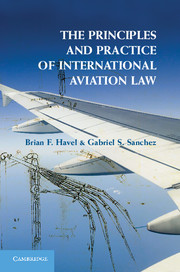Book contents
- Frontmatter
- Contents
- Preface
- Acknowledgments
- Table of Abbreviations and Acronyms
- 1 What is International Aviation Law?
- 2 The Foundations of Public International Aviation Law
- 3 The International Law Regime for Trade in Air Services
- 4 The International Law Regime for Airline Investment and Global Alliances
- 5 The International Law Regime for Aviation Safety and Security
- 6 The International Law Regime for Aviation and the Environment
- 7 The International Law Regime for Air Carrier Liability and Surface Damage
- 8 The International Law Regime for Aircraft Financing and Aircraft Nationality
- Afterword
- Select Bibliography
- Table of Authorities
- Index
- References
2 - The Foundations of Public International Aviation Law
Published online by Cambridge University Press: 05 June 2014
- Frontmatter
- Contents
- Preface
- Acknowledgments
- Table of Abbreviations and Acronyms
- 1 What is International Aviation Law?
- 2 The Foundations of Public International Aviation Law
- 3 The International Law Regime for Trade in Air Services
- 4 The International Law Regime for Airline Investment and Global Alliances
- 5 The International Law Regime for Aviation Safety and Security
- 6 The International Law Regime for Aviation and the Environment
- 7 The International Law Regime for Air Carrier Liability and Surface Damage
- 8 The International Law Regime for Aircraft Financing and Aircraft Nationality
- Afterword
- Select Bibliography
- Table of Authorities
- Index
- References
Summary
Background to the Chicago Convention
The cornerstone instrument of public international aviation law is the 1944 Convention on International Civil Aviation, popularly known as the “Chicago Convention” in honor of its birthplace. Even as the Second World War was reaching its fiery climax in the European and Asian theaters, United States (U.S.) President Franklin D. Roosevelt – responding to a British initiative – brought fifty-four Allied and neutral States to Chicago during the winter months of 1944 with the goal of developing an ordering mechanism for the world’s airspace and the nascent international air transport industry. The United States hoped that it could steer the negotiations toward affirming a (relatively) free market in aviation services, one which would give the U.S. airline industry – at the time the most developed and technologically sophisticated in the world – the opportunity to dominate the global marketplace. That ambition was not to be realized. Instead, the Convention’s scope was curtailed to solve technical coordination problems relating to, among other things, aircraft registry, air traffic management, cross-border recognition of licensing certificates, and the kinds of taxes and charges that could be imposed on international air services.
States, Not Airlines, Define Chicago’s Commercial Environment
Where the Convention does directly implicate economic rights for air carriers, it is typically in an illiberal key. States, not their airlines, are vested with the right to define international aviation’s commercial environment. That fact is not terribly surprising if one recalls the Chicago Convention’s historical context. Memories of the 1929 worldwide economic collapse were still fresh, and economic advisors on both sides of the Atlantic were flirting with the supposed benefits of a Soviet-style command economy. Even the United States, eventually a bastion of neoliberalism and globalization, tempered the market freedoms of its industrial sectors in the late nineteenth century when Congress passed the Sherman Antitrust Act and established the Interstate Commerce Commission. That regulatory impulse spread to the privately owned U.S. air transport industry, which since 1938 had been placed under the economic supervision of a public agency, the now-defunct Civil Aeronautics Board (CAB). European States, on the other hand, opted to couple regulation of their major airlines with outright public ownership.
- Type
- Chapter
- Information
- Publisher: Cambridge University PressPrint publication year: 2014



